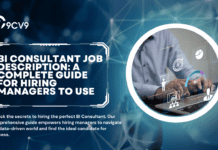Key Takeaways
- Compensation management software automates salary planning, pay equity analysis, and compliance to streamline HR processes.
- Key features include performance-based pay structures, real-time data analytics, and seamless payroll integration.
- Businesses benefit from improved transparency, cost optimization, and enhanced employee satisfaction with fair compensation strategies.
Compensation plays a pivotal role in shaping an organization’s workforce strategy.
A well-structured compensation plan ensures that employees are fairly rewarded for their contributions, fosters job satisfaction, and enhances retention rates.
However, managing compensation manually can be a complex and time-consuming process, especially for organizations with a large workforce.
This is where Compensation Management Software (CMS) comes into play—an advanced digital solution designed to streamline salary structures, bonuses, incentives, and other forms of employee compensation while ensuring accuracy, compliance, and efficiency.

In today’s competitive job market, businesses must offer competitive salaries and benefits to attract and retain top talent.
At the same time, they must ensure internal pay equity, align compensation with performance, and comply with labor laws and industry regulations.
Traditionally, HR and finance teams have relied on spreadsheets and manual calculations to determine employee compensation, which can be prone to errors and inconsistencies.
With the rise of digital transformation, companies are increasingly adopting Compensation Management Software to automate and optimize these processes, eliminating manual inefficiencies and enhancing strategic decision-making.
Compensation Management Software is more than just a payroll tool; it is an integrated system that allows organizations to design, implement, and manage comprehensive compensation plans.
Whether it is determining base salaries, handling performance-based incentives, managing stock options, or ensuring compliance with legal frameworks, a robust CMS provides HR teams with the tools they need to administer compensation programs with precision.
By leveraging data analytics and automation, CMS enables businesses to maintain pay transparency, reduce discrepancies, and align compensation structures with company goals and industry standards.
Moreover, modern Compensation Management Software integrates seamlessly with HR, payroll, and performance management systems, allowing organizations to make data-driven decisions.
Features such as salary benchmarking, compensation planning, predictive analytics, and automated approval workflows help HR professionals optimize pay structures while maintaining budget control.
Additionally, CMS often includes self-service portals, enabling employees to view their compensation details, access incentive breakdowns, and understand the factors influencing their pay, fostering transparency and trust within the organization.
The adoption of Compensation Management Software is rapidly growing across industries, from startups to multinational corporations.
Organizations recognize that a well-managed compensation system not only enhances operational efficiency but also strengthens employer branding by demonstrating a commitment to fair and equitable pay practices.
With advancements in artificial intelligence, cloud computing, and data analytics, CMS solutions are becoming more intelligent, scalable, and adaptable to the evolving needs of businesses.
In this comprehensive guide, we will explore what Compensation Management Software is, how it works, its key features, benefits, challenges, and the factors businesses should consider when selecting the right software.
By understanding the role of CMS in modern workforce management, organizations can make informed decisions that drive employee satisfaction, improve retention rates, and ensure compliance with compensation regulations.
Before we venture further into this article, we would like to share who we are and what we do.
About 9cv9
9cv9 is a business tech startup based in Singapore and Asia, with a strong presence all over the world.
With over nine years of startup and business experience, and being highly involved in connecting with thousands of companies and startups, the 9cv9 team has listed some important learning points in this overview of What is Compensation Management Software and How It Works.
If your company needs recruitment and headhunting services to hire top-quality employees, you can use 9cv9 headhunting and recruitment services to hire top talents and candidates. Find out more here, or send over an email to [email protected].
Or just post 1 free job posting here at 9cv9 Hiring Portal in under 10 minutes.
What is Compensation Management Software and How It Works
- What is Compensation Management Software and How It Works
- Key Features of Compensation Management Software
- How Compensation Management Software Works
- Benefits of Using Compensation Management Software
- Challenges of Implementing Compensation Management Software
- How to Choose the Right Compensation Management Software
- Future Trends in Compensation Management Software
1. What is Compensation Management Software and How It Works
Compensation Management Software (CMS) is a specialized digital solution designed to help businesses plan, administer, and optimize employee compensation, including salaries, bonuses, incentives, stock options, and benefits. It provides HR teams and finance professionals with a structured framework to ensure fair and competitive pay practices while aligning compensation strategies with business objectives.
Modern CMS solutions integrate with HR, payroll, and performance management systems, offering automation, analytics, and compliance features that streamline compensation planning. By leveraging technology, organizations can eliminate manual errors, enhance transparency, and make data-driven compensation decisions that boost employee satisfaction and retention.
Key Functions of Compensation Management Software
1. Centralized Compensation Planning and Management
- Allows organizations to create and manage compensation structures in a centralized platform.
- Ensures consistent salary bands, pay grades, and incentive structures across departments.
- Reduces reliance on spreadsheets and manual calculations.
- Example: Workday Compensation offers a structured compensation planning module that integrates seamlessly with payroll and performance management systems.
2. Automated Salary and Bonus Calculations
- Ensures accurate salary computations based on predefined formulas and pay structures.
- Automates performance-based pay adjustments, bonuses, and commissions.
- Reduces manual errors that often occur in traditional salary processing.
- Example: SAP SuccessFactors Compensation automates merit-based salary adjustments and bonus calculations to improve efficiency.
3. Performance-Based Compensation Management
- Links employee pay to performance metrics and KPIs.
- Automates bonus and incentive payments based on individual, team, or company performance.
- Ensures transparency in pay-for-performance models.
- Example: Oracle HCM Cloud uses AI-driven analytics to assess employee performance and recommend compensation adjustments.
4. Budget Allocation and Forecasting
- Provides HR teams with budget control tools to allocate compensation funds efficiently.
- Helps organizations forecast salary expenditures for different financial scenarios.
- Ensures cost-effective compensation planning without exceeding budget limits.
- Example: CompXL enables organizations to set and monitor compensation budgets while providing insights into future compensation trends.
5. Equity and Stock Option Management
- Facilitates the administration of stock-based compensation, such as RSUs (Restricted Stock Units) and stock options.
- Ensures compliance with equity distribution policies and vesting schedules.
- Allows employees to track their stock options in real-time.
- Example: Carta is widely used by startups and enterprises to manage employee equity compensation plans.
6. Compliance with Compensation Laws and Regulations
- Ensures adherence to labor laws, equal pay regulations, and tax compliance.
- Helps companies comply with legal frameworks such as FLSA (Fair Labor Standards Act), GDPR, and country-specific wage laws.
- Provides audit trails and automated compliance reports to minimize legal risks.
- Example: PayScale offers real-time compensation benchmarking and compliance tools to ensure fair pay practices.
7. Compensation Benchmarking and Market Analysis
- Compares internal salary structures with industry standards.
- Provides real-time market data to help HR teams determine competitive salaries.
- Ensures organizations attract and retain top talent by offering competitive pay packages.
- Example: Salary.com provides compensation benchmarking tools that help organizations adjust salaries based on industry trends.
8. Employee Self-Service and Transparency
- Allows employees to access their salary details, bonus breakdowns, and compensation history.
- Enhances transparency and trust by providing insights into how compensation decisions are made.
- Reduces HR workload by enabling employees to view and request compensation changes via self-service portals.
- Example: ADP Workforce Now provides employees with a self-service portal to track salary and benefits in real time.
Who Uses Compensation Management Software?
1. HR Professionals and Compensation Analysts
- Design and manage salary structures, bonus programs, and incentive plans.
- Ensure internal pay equity and external competitiveness.
- Analyze compensation data to make informed salary decisions.
2. Finance and Payroll Teams
- Monitor compensation budgets and forecast salary expenses.
- Ensure accurate payroll processing with automated compensation calculations.
- Maintain compliance with tax laws and labor regulations.
3. Business Leaders and Executives
- Align compensation strategies with business objectives and financial goals.
- Make data-driven decisions to attract and retain top talent.
- Ensure company-wide pay transparency and fairness.
4. Employees and Managers
- Employees access their compensation details, incentives, and stock options through self-service portals.
- Managers review and approve compensation changes for their teams.
- HR and leadership teams ensure equitable compensation distribution.
Why is Compensation Management Software Important?
1. Enhances Accuracy and Reduces Errors
- Eliminates manual salary calculations and reduces human errors.
- Ensures payroll consistency across departments and locations.
2. Improves Employee Satisfaction and Retention
- Employees feel valued when they receive fair and transparent compensation.
- Competitive pay structures help organizations attract top talent and reduce turnover rates.
3. Streamlines Compensation Planning and Execution
- Automates the entire compensation cycle, from budgeting to payouts.
- Reduces administrative burden for HR and finance teams.
4. Ensures Legal Compliance
- Minimizes risks of non-compliance with labor laws and industry regulations.
- Provides audit trails and compliance reports for regulatory bodies.
5. Enhances Strategic Decision-Making
- Provides compensation analytics and benchmarking data to HR and leadership teams.
- Helps businesses stay competitive in the talent market by adjusting salary structures based on industry trends.
Conclusion
Compensation Management Software is an essential tool for modern businesses looking to optimize salary structures, manage incentives, and ensure fair and compliant pay practices. By automating compensation planning, enhancing transparency, and integrating with HR systems, CMS helps organizations make data-driven decisions that support employee satisfaction and business success. Whether for a startup managing equity compensation or a multinational corporation streamlining global payroll, a robust CMS solution can significantly improve compensation strategies and workforce management.
2. Key Features of Compensation Management Software
Compensation Management Software (CMS) offers a range of powerful features designed to streamline salary planning, automate incentive distribution, and ensure compliance with labor laws. These features help organizations maintain transparency, improve accuracy, and optimize compensation structures. Below are the essential features of CMS and how they contribute to effective compensation management.
1. Compensation Planning and Budgeting
- Centralized compensation planning: Enables organizations to design and manage compensation structures, salary bands, and bonus plans from a single platform.
- Budget allocation tools: Allows HR and finance teams to allocate funds efficiently for salary increments, bonuses, and incentives.
- Scenario planning: Helps organizations forecast compensation costs based on business performance, market trends, and workforce expansion.
- Example: Workday Compensation provides tools for planning and managing salary budgets while ensuring cost control.
2. Automated Salary and Incentive Calculations
- Automated salary adjustments: Ensures accurate salary increases based on tenure, performance, or promotions.
- Bonus and commission calculations: Automates the calculation of performance-based bonuses and sales commissions based on predefined criteria.
- Payroll system integration: Syncs with payroll software to streamline salary disbursement and tax deductions.
- Example: SAP SuccessFactors Compensation automates salary adjustments and bonus calculations based on employee performance metrics.
3. Performance-Based Compensation Management
- Merit-based salary increments: Links employee compensation to performance appraisals and productivity metrics.
- Incentive and rewards programs: Enables organizations to design incentive structures that align with business goals.
- KPI-based pay structures: Adjusts compensation dynamically based on individual, team, or company-wide performance.
- Example: Oracle HCM Cloud uses AI-driven analytics to assess employee performance and recommend compensation adjustments.
4. Compensation Benchmarking and Market Analysis
- Real-time salary benchmarking: Provides insights into industry pay trends to help businesses stay competitive.
- Custom compensation reports: Generates reports that compare internal salary structures with market standards.
- Competitor salary insights: Helps businesses make data-driven decisions by analyzing salary trends in similar industries.
- Example: PayScale offers real-time salary benchmarking and market insights to ensure fair and competitive pay.
5. Equity and Stock Option Management
- Stock-based compensation tracking: Manages stock options, Restricted Stock Units (RSUs), and employee stock purchase plans (ESPPs).
- Vesting schedule management: Automates the tracking of vesting periods and grant allocations.
- Real-time equity monitoring: Allows employees to view their stock options and expected returns.
- Example: Carta is widely used for managing stock-based compensation plans for startups and enterprises.
6. Compliance with Compensation Laws and Regulations
- Automated compliance checks: Ensures salary structures align with labor laws, minimum wage regulations, and equal pay policies.
- Audit and reporting tools: Generates detailed reports to help HR teams comply with local and international labor regulations.
- Data security and privacy controls: Ensures employee compensation data is protected against unauthorized access.
- Example: Salary.com helps businesses comply with fair pay regulations through compensation analysis and compliance reports.
7. Compensation Analytics and Reporting
- Real-time compensation insights: Provides dashboards with salary trends, pay gaps, and compensation structures.
- Predictive analytics: Uses AI-driven insights to forecast future compensation costs and trends.
- Customizable reports: Allows HR teams to generate reports based on compensation data, performance metrics, and financial projections.
- Example: Xactly Incent provides in-depth compensation analytics to optimize pay structures and financial planning.
8. Employee Self-Service Portals
- Compensation transparency: Allows employees to access salary details, bonus breakdowns, and stock option records.
- Request-based compensation changes: Enables employees to request salary reviews or performance-based bonuses through the platform.
- Mobile access: Many CMS platforms offer mobile applications for employees to check their compensation data on the go.
- Example: ADP Workforce Now provides an employee self-service portal where staff can track salaries, benefits, and incentives.
9. Workflow Automation and Approval Management
- Role-based access control: Ensures that only authorized personnel can approve salary changes and bonuses.
- Automated approval workflows: Speeds up the compensation approval process by reducing manual interventions.
- Notifications and reminders: Alerts managers and HR professionals about pending compensation requests or budget limits.
- Example: CompXL offers workflow automation for salary adjustments and bonus approvals, ensuring a seamless compensation process.
10. Integration with HR and Payroll Systems
- Seamless HRIS integration: Works with Human Resource Information Systems (HRIS) to manage employee data and payroll.
- API-based connectivity: Allows businesses to integrate their compensation software with existing HR and finance platforms.
- Payroll automation: Syncs with payroll systems to ensure accurate salary disbursement without duplication of data.
- Example: UKG Pro integrates compensation management with HR, benefits administration, and payroll processing.
11. Pay Equity and Diversity Analysis
- Gender pay gap analysis: Identifies discrepancies in compensation based on gender, ethnicity, or job role.
- Fair pay audits: Ensures organizations maintain equitable pay practices and comply with diversity policies.
- Compensation transparency reports: Helps businesses create fair and inclusive salary structures.
- Example: Syndio provides AI-driven pay equity analysis to eliminate wage gaps and ensure compliance with equal pay regulations.
12. Multi-Currency and Global Compensation Management
- Multi-currency payroll processing: Supports international salary structures and currency conversions.
- Regional compliance tracking: Ensures adherence to labor laws and tax regulations across different countries.
- Localization support: Adapts compensation plans based on cost-of-living adjustments and regional salary trends.
- Example: Remote.com provides global compensation management tools to support businesses with distributed teams worldwide.
13. Compensation Strategy Customization
- Flexible compensation models: Supports various pay structures, including fixed salaries, variable pay, and profit-sharing models.
- Customizable incentive plans: Allows businesses to design unique compensation strategies tailored to their workforce.
- Employee-specific compensation plans: Enables personalized salary structures based on job roles, experience, and skill levels.
- Example: Cornerstone Compensation Management offers configurable compensation models that align with business needs.
Conclusion
Compensation Management Software is a powerful tool that helps organizations efficiently manage salaries, bonuses, stock options, and incentive plans while ensuring compliance with labor laws. By leveraging features such as automated salary calculations, real-time compensation analytics, pay equity monitoring, and seamless payroll integration, businesses can create competitive compensation strategies that drive employee satisfaction and retention. Whether a company is a growing startup or a multinational enterprise, investing in the right CMS solution can significantly enhance workforce compensation planning and overall business success.
3. How Compensation Management Software Works
Compensation Management Software (CMS) streamlines the process of planning, administering, and executing compensation strategies within an organization. It automates salary adjustments, bonus calculations, and equity distribution while ensuring compliance with industry standards and labor laws. Below is a comprehensive breakdown of how CMS functions, from data collection to final salary disbursement.
1. Data Collection and Integration
Compensation Management Software integrates with multiple HR, payroll, and finance systems to collect relevant compensation data.
- HRIS (Human Resource Information System) Integration:
- Pulls employee details such as job titles, experience, performance records, and salary history.
- Example: Workday Compensation syncs with HRIS platforms to provide real-time employee salary data.
- Payroll System Connectivity:
- Links with payroll software to ensure accurate salary processing and tax deductions.
- Example: ADP Workforce Now integrates with payroll systems to streamline salary payments.
- Market Benchmarking Data Import:
- Imports compensation trends from external market sources for competitive salary benchmarking.
- Example: Payscale provides industry salary insights to help companies make data-driven pay decisions.
- Performance Management System Integration:
- Pulls performance evaluation metrics to determine merit-based pay adjustments.
- Example: SAP SuccessFactors Compensation integrates with performance review systems to align pay with employee contributions.
2. Compensation Planning and Budget Allocation
CMS enables HR and finance teams to develop compensation plans while managing salary budgets effectively.
- Salary Budget Allocation:
- Determines salary increases, incentive distribution, and cost-of-living adjustments.
- Ensures budget constraints are met while optimizing employee compensation.
- Compensation Strategy Configuration:
- Allows organizations to set up different pay structures, including fixed pay, variable pay, bonuses, and stock options.
- Example: UKG Pro provides customizable salary structures based on organizational policies.
- Scenario Analysis and Forecasting:
- Uses predictive analytics to evaluate the financial impact of compensation changes.
- Example: Xactly Incent helps businesses plan incentive programs while forecasting future salary expenses.
3. Automated Salary and Bonus Calculation
CMS automates the process of calculating salary increments, bonuses, and commissions to ensure accuracy and efficiency.
- Base Salary Adjustments:
- Automatically updates salaries based on promotion cycles, tenure, and inflation rates.
- Example: CompXL provides automated pay adjustments based on predefined company rules.
- Performance-Based Bonus Calculations:
- Links incentives to individual and company performance metrics.
- Example: Oracle HCM Cloud calculates bonuses based on key performance indicators (KPIs).
- Commission and Sales Incentive Management:
- Tracks sales performance and automates commission payouts.
- Example: Varicent enables businesses to manage complex commission structures for sales teams.
4. Pay Equity and Compliance Management
CMS ensures that organizations follow fair pay practices and adhere to labor laws.
- Automated Pay Equity Audits:
- Identifies salary discrepancies based on gender, experience, and job roles.
- Example: Syndio provides pay equity analysis to eliminate wage gaps.
- Regulatory Compliance Checks:
- Ensures salary structures comply with minimum wage laws and equal pay regulations.
- Example: Salary.com helps businesses meet compliance requirements through detailed compensation reports.
- Taxation and Benefits Management:
- Calculates tax deductions, social security contributions, and employee benefits.
- Example: Rippling automates payroll tax compliance and benefits administration.
5. Compensation Approval Workflow Automation
CMS streamlines the process of approving salary changes and incentive payouts.
- Role-Based Access Control:
- Ensures that only authorized personnel can approve salary adjustments and bonuses.
- Automated Compensation Review Process:
- Notifies HR managers and finance teams for approval of salary adjustments.
- Example: Compport automates multi-level approval workflows for compensation decisions.
- Real-Time Compensation Change Notifications:
- Alerts employees about salary revisions and incentive updates.
6. Employee Self-Service and Transparency
CMS allows employees to access their compensation details through a self-service portal.
- Salary and Bonus Breakdown:
- Employees can view their pay structure, including base salary, incentives, and stock options.
- Example: ADP Workforce Now provides employees with a transparent breakdown of their compensation.
- Stock Options and Equity Tracking:
- Employees can monitor the vesting schedule of their stock options.
- Example: Carta enables employees to track stock-based compensation in real time.
- Compensation Queries and Requests:
- Employees can submit salary review requests and track their approval status.
7. Compensation Analytics and Reporting
CMS provides in-depth insights into compensation trends, pay disparities, and financial planning.
- Compensation Data Dashboards:
- Displays real-time salary trends, pay gaps, and compensation ratios.
- Predictive Compensation Modeling:
- Uses AI-driven insights to project future compensation costs.
- Example: Xactly Insights uses machine learning to predict compensation trends.
- Customizable Reports for HR and Finance Teams:
- Generates reports on salary distribution, incentive spending, and pay equity analysis.
- Example: Cornerstone Compensation Management provides data-driven reports for better decision-making.
8. Multi-Currency and Global Compensation Management
For organizations operating internationally, CMS ensures seamless global payroll processing.
- Multi-Currency Payroll Processing:
- Automatically converts salaries to local currencies for global employees.
- Regional Compliance Tracking:
- Adapts compensation structures based on regional labor laws.
- Example: Remote.com offers global payroll and compliance solutions for distributed teams.
- Localization Support:
- Adjusts compensation based on cost-of-living differences in various locations.
9. Integration with Payroll Processing
Once compensation calculations are finalized, CMS integrates with payroll systems to ensure accurate salary disbursement.
- Seamless Payroll Synchronization:
- Transfers approved salary adjustments to payroll software for processing.
- Example: Paylocity integrates compensation management with payroll execution.
- Automated Salary Disbursement:
- Ensures timely payment of salaries, bonuses, and incentives.
- Tax Filing and Deduction Compliance:
- Calculates tax withholdings based on employee earnings and benefits.
10. Continuous Compensation Strategy Optimization
Organizations use CMS to refine their compensation plans regularly.
- Real-Time Compensation Audits:
- Continuously monitors salary structures to ensure competitiveness.
- AI-Driven Compensation Recommendations:
- Suggests salary adjustments based on market trends and performance data.
- Example: Anaplan Compensation Planning offers AI-powered recommendations for pay increases.
- Employee Satisfaction and Retention Analysis:
- Assesses how compensation impacts employee engagement and retention rates.
Conclusion
Compensation Management Software plays a critical role in streamlining salary planning, ensuring compliance, and enhancing employee satisfaction. By integrating with HR, payroll, and financial systems, it automates the entire compensation lifecycle—from data collection and budget allocation to salary disbursement and compliance monitoring. Organizations that leverage CMS can create competitive, fair, and data-driven compensation strategies, ultimately boosting workforce engagement and retention.
4. Benefits of Using Compensation Management Software
Compensation Management Software (CMS) offers numerous advantages for businesses by automating and optimizing salary planning, incentive distribution, and pay structure management. It enhances accuracy, ensures compliance, and helps organizations maintain competitive compensation strategies. Below is a detailed breakdown of the key benefits of using Compensation Management Software.
1. Increased Accuracy and Reduced Errors
Manual compensation management can lead to costly payroll errors. CMS ensures precision in salary calculations, tax deductions, and bonus allocations.
- Automated Pay Calculations:
- Ensures accurate computation of salaries, bonuses, and stock options.
- Example: Workday Compensation automates salary adjustments, reducing human errors in payroll.
- Error-Free Tax Deductions:
- Integrates with payroll systems to apply the correct tax rates and social security deductions.
- Example: ADP Workforce Now ensures compliance with tax regulations through automated payroll tax calculations.
- Eliminates Data Entry Mistakes:
- Reduces the risk of manual input errors by integrating directly with HR and finance databases.
2. Improved Compliance and Regulatory Adherence
CMS helps organizations stay compliant with labor laws, wage regulations, and tax policies by automating legal requirements.
- Automated Compliance Monitoring:
- Tracks changes in employment laws and updates salary structures accordingly.
- Example: Rippling automatically updates payroll tax rules based on regulatory changes.
- Pay Equity Audits:
- Identifies and corrects gender pay gaps or wage disparities within the company.
- Example: Syndio provides real-time pay equity analysis to ensure fair compensation practices.
- Multi-Country Compliance Support:
- Helps global organizations adhere to regional labor laws, such as minimum wage requirements and overtime policies.
- Example: Remote.com ensures compliance with international employment laws.
3. Enhanced Employee Satisfaction and Retention
A well-managed compensation system leads to increased employee trust and reduced turnover.
- Transparent Salary Structures:
- Employees can view their pay breakdown, bonus calculations, and stock options.
- Example: Payscale provides employees with real-time salary market comparisons.
- Recognition and Reward System:
- Performance-based incentives motivate employees to achieve company goals.
- Example: Xactly Incent automates sales commission calculations, encouraging sales teams to perform better.
- Fair and Competitive Pay:
- Ensures that salaries align with market rates, preventing employee dissatisfaction.
- Example: Salary.com offers compensation benchmarking tools to maintain competitive pay structures.
4. Increased Efficiency and Time Savings
CMS automates complex compensation processes, freeing HR professionals from manual calculations and paperwork.
- Automated Salary Planning:
- Reduces administrative workload by auto-updating pay scales and bonus allocations.
- Example: CompXL streamlines salary revision cycles with bulk compensation updates.
- Quick Compensation Approvals:
- Speeds up the salary review process through automated approval workflows.
- Example: Compport enables real-time salary adjustment approvals through a centralized dashboard.
- Seamless Payroll Integration:
- Directly connects with payroll software to ensure timely salary disbursements.
- Example: Paylocity synchronizes compensation data with payroll for smooth processing.
5. Data-Driven Decision Making
CMS provides analytics and insights to help HR teams make informed compensation decisions.
- Real-Time Compensation Dashboards:
- Displays salary trends, budget allocation, and incentive spending in visual reports.
- Predictive Compensation Modeling:
- Uses AI-driven insights to forecast future compensation expenses.
- Example: Xactly Insights offers predictive analytics for better incentive planning.
- Salary Benchmarking Reports:
- Compares internal pay structures with industry standards to maintain competitive wages.
- Example: Cornerstone Compensation Management provides salary benchmarking data for HR teams.
6. Improved Budget Management
CMS helps businesses manage their compensation budgets effectively, preventing overspending.
- Cost Control and Forecasting:
- Analyzes salary expenses to align with business financial goals.
- Example: Anaplan Compensation Planning assists companies in budgeting for salaries and bonuses.
- Scenario-Based Compensation Planning:
- Helps organizations simulate different salary increase scenarios to assess financial impact.
- Better Incentive Allocation:
- Ensures that performance bonuses and commissions are distributed efficiently without exceeding budget limits.
7. Increased Pay Transparency
Compensation transparency fosters trust between employers and employees, reducing disputes over salaries and incentives.
- Self-Service Compensation Portals:
- Employees can access their salary, benefits, and incentive breakdown in real-time.
- Example: ADP Workforce Now offers employees a detailed pay summary through its portal.
- Clear Bonus and Commission Calculations:
- Helps employees understand how their incentives are determined.
- Example: Varicent automates commission tracking, allowing employees to see their earnings projections.
8. Scalability for Growing Businesses
CMS supports organizations as they scale by handling complex compensation structures with ease.
- Multi-Level Compensation Management:
- Accommodates different pay scales for junior, mid-level, and senior employees.
- Flexible Pay Structures:
- Adapts to evolving salary models, including remote work pay adjustments.
- Global Expansion Support:
- Manages compensation across different regions with multi-currency payroll features.
- Example: Papaya Global supports international payroll and multi-currency salary payments.
9. Competitive Advantage in Talent Acquisition
A well-structured compensation system attracts top talent by offering competitive and well-managed salary packages.
- Market-Competitive Salary Packages:
- Ensures job offers remain attractive by benchmarking against industry pay rates.
- Example: Payscale helps HR teams design competitive salary offers based on market data.
- Customizable Employee Benefits Packages:
- Allows businesses to offer flexible benefits, including bonuses and stock options.
- Faster Offer Letter Generation:
- Automates salary offer approvals, reducing hiring delays.
10. Enhanced Security and Data Protection
CMS ensures that salary data remains confidential and protected from unauthorized access.
- Role-Based Access Control (RBAC):
- Limits salary-related data access to authorized HR personnel.
- Data Encryption and Compliance:
- Ensures employee pay data is securely stored and adheres to data privacy laws.
- Example: Workday Compensation provides secure, GDPR-compliant compensation management.
- Audit Trails for Payroll Transactions:
- Tracks all salary changes and bonus payments for accountability and compliance.
Conclusion
Compensation Management Software provides businesses with an efficient, accurate, and scalable solution for managing employee salaries and incentives. It eliminates payroll errors, ensures compliance, enhances transparency, and boosts employee satisfaction. By leveraging real-time analytics, automation, and seamless integrations, organizations can build fair, competitive, and data-driven compensation strategies that support business growth and employee retention.
5. Challenges of Implementing Compensation Management Software
While Compensation Management Software (CMS) offers numerous advantages, organizations may face several challenges when implementing it. These obstacles range from technical difficulties to resistance from employees and regulatory concerns. Understanding these challenges can help businesses develop strategies to overcome them and maximize the benefits of CMS.
1. High Initial Costs and Budget Constraints
Implementing CMS requires a significant financial investment, which may pose challenges for small and medium-sized enterprises (SMEs).
- Software Licensing and Subscription Fees:
- Many CMS solutions require upfront licensing fees or recurring subscription costs.
- Example: Workday Compensation has a high licensing fee that may be expensive for startups.
- Implementation and Integration Costs:
- Businesses may need to spend on customization, data migration, and system integration.
- Example: SAP SuccessFactors Compensation requires additional configuration costs for integration with existing HR tools.
- Training and Change Management Costs:
- Employees and HR teams need to be trained on how to use the new software.
- Example: Companies using Oracle Compensation Cloud may need extensive training to navigate its complex features.
2. Complexity in System Integration
Integrating CMS with existing payroll, HR, and finance systems can be challenging, particularly in large organizations.
- Compatibility Issues with Legacy Systems:
- Older HR systems may not support modern CMS tools, requiring upgrades or workarounds.
- Example: Businesses using outdated payroll software may struggle to integrate with cloud-based solutions like Paylocity.
- Data Migration Challenges:
- Transferring historical compensation data from spreadsheets or legacy systems may lead to inconsistencies.
- Example: A company shifting from manual salary calculations to Payscale may experience data formatting issues.
- Real-Time Synchronization Problems:
- Some CMS tools may not update data in real-time, leading to discrepancies in payroll and budgeting.
3. Resistance to Change from Employees and HR Teams
Employees and HR personnel may resist transitioning to automated compensation management due to unfamiliarity or fear of job redundancy.
- Employee Skepticism:
- Employees may distrust automated systems for salary calculations and bonus distribution.
- Example: Workers may question the accuracy of performance-based pay calculations in Xactly Incent.
- HR Teams’ Reluctance to Adapt:
- HR professionals accustomed to traditional methods may find it difficult to transition to digital compensation planning.
- Concerns About Job Security:
- Automation may be perceived as a threat to HR professionals managing payroll and compensation manually.
4. Data Security and Privacy Risks
Compensation data contains sensitive employee information, making security a primary concern for organizations.
- Risk of Data Breaches:
- Unauthorized access to compensation data could lead to financial fraud and privacy violations.
- Example: A cybersecurity breach in ADP Workforce Now could expose salary details of thousands of employees.
- Compliance with Data Protection Regulations:
- Companies need to ensure compliance with data security laws such as GDPR, CCPA, and HIPAA.
- Example: Multi-national corporations using Remote.com must comply with different regional data protection laws.
- User Access Control Challenges:
- Improper role-based access settings may allow unauthorized personnel to view confidential salary information.
5. Customization and Scalability Limitations
Organizations with unique compensation structures may find it difficult to tailor CMS to their specific needs.
- Lack of Customization Options:
- Some software solutions may not offer flexibility in salary structures, commission models, or bonuses.
- Example: Companies using BambooHR Compensation may find it challenging to customize incentive plans for different job levels.
- Scalability Issues for Growing Businesses:
- As companies expand, they may need advanced compensation management features that basic CMS tools do not support.
- Example: Startups using Gusto may need to switch to more scalable solutions like SAP SuccessFactors as they grow.
- Industry-Specific Compensation Challenges:
- Some industries have complex compensation structures that standard CMS solutions may not accommodate.
- Example: Sales-driven organizations may need a highly customizable commission management system like Varicent.
6. Compliance and Legal Challenges
Managing compensation across different countries with varying labor laws can be difficult for multinational companies.
- Regulatory Variations Across Regions:
- Compensation structures must align with tax laws, minimum wage regulations, and employment policies in different countries.
- Example: A company using Papaya Global for global payroll may need to adjust pay structures based on local labor laws.
- Frequent Changes in Tax Laws and Benefits Regulations:
- Keeping CMS updated with evolving tax and benefits regulations can be challenging.
- Example: Businesses using Rippling need to constantly monitor tax law changes to ensure compliance.
- Challenges with Pay Equity and Anti-Discrimination Laws:
- Organizations must ensure that compensation aligns with equal pay laws to avoid legal disputes.
- Example: Syndio provides pay equity analysis to help organizations meet legal requirements.
7. Performance-Linked Compensation Issues
CMS solutions that rely on performance-based pay structures may encounter fairness and accuracy challenges.
- Difficulty in Setting Fair Performance Metrics:
- Some employees may feel their contributions are undervalued in automated incentive calculations.
- Example: Sales teams using Xactly Incent may dispute commission calculations if performance metrics are not transparent.
- Subjectivity in Performance Appraisals:
- If the CMS is linked to performance reviews, biases in evaluations could affect salary increments and bonuses.
- Employee Discontent with Bonus Distribution:
- Employees may dispute automated bonus allocations, leading to dissatisfaction and reduced morale.
8. Time-Consuming Implementation Process
Deploying CMS can take weeks or months, depending on the complexity of the organization’s compensation structure.
- Lengthy Software Configuration and Setup:
- Businesses may need extensive time to configure pay scales, benefits, and incentive models.
- Example: Companies using Cornerstone Compensation Management may require months to fully implement the system.
- Employee Training and Adoption Delays:
- Organizations need to ensure that HR teams and managers are adequately trained in using the software.
- Testing and Troubleshooting Period:
- Bugs, miscalculations, and integration issues may need time to resolve before the system runs smoothly.
9. Lack of User-Friendly Interfaces
Some CMS tools have complex interfaces that require extensive training for HR teams and employees.
- Difficult Navigation and Poor UX Design:
- Non-intuitive dashboards can slow down adoption and productivity.
- Example: Oracle Compensation Cloud has an advanced but complex UI that requires extensive training.
- Mobile Accessibility Challenges:
- Employees may struggle to access compensation details on mobile devices if the platform is not mobile-friendly.
- Limited Self-Service Features for Employees:
- Some CMS solutions lack self-service portals where employees can view their pay and benefits details.
10. Limited Vendor Support and Customer Service Issues
Organizations relying on CMS vendors for system maintenance and troubleshooting may face customer support challenges.
- Slow Vendor Response Times:
- Delayed issue resolution can disrupt payroll and employee compensation cycles.
- Limited Customization Support:
- Some vendors offer limited options for modifying CMS features to meet specific business needs.
- Software Downtime and Technical Glitches:
- Frequent system crashes or maintenance periods may affect payroll accuracy.
- Example: Companies using ADP Workforce Now have reported occasional system downtimes affecting payroll processing.
Conclusion
While Compensation Management Software can revolutionize payroll and incentive management, organizations must address these challenges to ensure successful implementation. By choosing the right software, investing in training, and ensuring compliance with legal regulations, businesses can maximize the benefits of CMS while minimizing potential risks.
6. How to Choose the Right Compensation Management Software
Selecting the right Compensation Management Software (CMS) is crucial for businesses looking to streamline salary planning, bonuses, and performance-based incentives. The ideal software should align with the company’s compensation structure, integrate seamlessly with existing HR tools, and comply with legal regulations. This guide outlines the key factors to consider when choosing a CMS to optimize payroll management and enhance employee satisfaction.
1. Identify Business Needs and Compensation Goals
Before selecting a CMS, organizations must assess their compensation structure and objectives.
- Evaluate Compensation Strategies:
- Determine whether the company focuses on base salaries, bonuses, commissions, or performance-based pay.
- Example: A sales-driven company may require commission-based compensation software like Xactly Incent.
- Assess Employee Demographics and Payroll Complexity:
- Consider the size of the workforce, geographic locations, and diverse compensation models.
- Example: A multinational company with employees in different countries may need a global payroll system like Papaya Global.
- Define Key Features Required:
- Identify essential functionalities such as salary benchmarking, analytics, and compliance tracking.
2. Consider Software Scalability and Flexibility
As businesses grow, their compensation needs evolve, requiring software that can scale accordingly.
- Ensure the Software Can Handle Business Expansion:
- Choose a system that supports an increasing number of employees and changing pay structures.
- Example: Workday Compensation is suitable for enterprises that need scalability for global workforce expansion.
- Customization Options for Different Pay Structures:
- Some organizations require flexible compensation models, including stock options and bonuses.
- Example: Compport allows companies to tailor compensation plans for different employee levels.
- Industry-Specific Compensation Management:
- Businesses in finance, healthcare, or sales may require industry-specific compensation features.
3. Integration with Existing HR and Payroll Systems
A CMS should integrate seamlessly with HR software, payroll processing tools, and financial management platforms.
- Compatibility with HR Management Systems (HRMS):
- Ensure the software integrates with existing HR solutions like BambooHR or UKG Pro.
- Real-Time Data Synchronization with Payroll Software:
- Avoid payroll discrepancies by choosing software that syncs with payroll tools like ADP Workforce Now.
- Integration with Performance Management Systems:
- Software should link with performance appraisal tools to automate performance-based pay decisions.
4. Compliance with Legal and Regulatory Requirements
Ensuring compliance with labor laws, tax regulations, and data privacy policies is essential for avoiding legal risks.
- Adherence to Regional and Global Labor Laws:
- The software should automatically update tax codes and labor policies based on location.
- Example: Remote.com ensures compliance with country-specific employment laws.
- Pay Equity and Anti-Discrimination Features:
- Look for tools that support fair compensation practices to comply with equal pay laws.
- Example: Syndio provides pay equity analysis to prevent wage gaps.
- GDPR and Data Privacy Compliance:
- Ensure the CMS complies with data protection laws such as GDPR and CCPA.
5. User-Friendliness and Accessibility
A compensation management system should be easy to use for HR professionals, managers, and employees.
- Intuitive Dashboard and Navigation:
- HR teams should be able to configure compensation plans without extensive training.
- Example: Payscale provides a user-friendly interface for salary benchmarking.
- Self-Service Portal for Employees:
- Employees should have access to their compensation details, bonuses, and benefits.
- Mobile Accessibility for Remote Workforce:
- A cloud-based CMS with mobile compatibility allows employees to check compensation details on the go.
6. Advanced Analytics and Reporting Capabilities
Data-driven decision-making is crucial for effective compensation planning.
- Real-Time Compensation Insights:
- Choose software with real-time salary analytics and performance tracking.
- Example: SAP SuccessFactors Compensation provides detailed compensation reports for strategic planning.
- Customizable Reports for HR and Finance Teams:
- Software should generate compensation reports that align with business goals.
- Predictive Analytics for Compensation Planning:
- AI-driven analytics can help companies forecast compensation budgets and market trends.
7. Budget Considerations and Cost-Effectiveness
Selecting a CMS within the company’s budget while ensuring value for money is crucial.
- Compare Pricing Models:
- Some software providers charge a flat rate, while others have a per-user pricing model.
- Example: Gusto offers an affordable solution for small businesses with simple compensation needs.
- Evaluate Total Cost of Ownership (TCO):
- Consider costs beyond licensing, including implementation, training, and support fees.
- Check for Hidden Fees:
- Some providers charge extra for premium features or software updates.
8. Vendor Reputation and Customer Support
Choosing a reliable CMS provider ensures long-term support and software updates.
- Research Vendor Reviews and Case Studies:
- Look for testimonials from companies in similar industries.
- Example: Oracle Compensation Cloud is used by large enterprises with complex payroll structures.
- Evaluate Customer Support Availability:
- 24/7 customer support ensures smooth implementation and troubleshooting.
- Check for Training Resources and Onboarding Support:
- Some vendors offer detailed training manuals and live support for HR teams.
9. Security and Data Protection Measures
Since compensation data is highly sensitive, security features are a top priority.
- Role-Based Access Control (RBAC):
- Ensure only authorized personnel can access specific salary and compensation details.
- Data Encryption and Secure Cloud Storage:
- Software should use encryption protocols to prevent data breaches.
- Regular Security Audits and Compliance Checks:
- The vendor should conduct security audits to maintain data integrity.
10. Trial Period and Software Demo Availability
Before making a final decision, businesses should test the CMS through free trials or software demos.
- Request a Free Trial or Live Demo:
- Hands-on experience allows companies to assess functionality before committing.
- Evaluate Ease of Setup and Configuration:
- Test whether the software is easy to implement with minimal IT support.
- Compare Multiple Software Solutions:
- Shortlist two or three vendors and compare features side by side.
Conclusion
Choosing the right Compensation Management Software requires a thorough evaluation of business needs, software capabilities, compliance requirements, and cost-effectiveness. Organizations should prioritize scalability, ease of use, integration with existing systems, and advanced analytics when selecting a CMS. By conducting trials, comparing vendors, and ensuring legal compliance, businesses can implement a compensation system that enhances payroll efficiency and supports long-term growth.
7. Future Trends in Compensation Management Software
The field of compensation management is undergoing rapid transformation due to advancements in artificial intelligence (AI), automation, and data analytics. As businesses strive for efficiency, compliance, and employee satisfaction, compensation management software (CMS) is evolving to incorporate cutting-edge technologies and innovative approaches. Below is a comprehensive look at the key trends shaping the future of compensation management software.
1. AI and Machine Learning for Compensation Optimization
Artificial intelligence (AI) and machine learning (ML) are revolutionizing compensation management by providing data-driven insights and automating salary decisions.
- AI-Powered Salary Benchmarking and Pay Equity Analysis
- AI analyzes industry salary data to suggest competitive compensation structures.
- Helps organizations reduce pay gaps and ensure fair wages.
- Example: Payscale Insight Lab uses AI to benchmark salaries and recommend equitable pay structures.
- Predictive Analytics for Compensation Planning
- ML models forecast salary trends, inflation rates, and future compensation costs.
- Enables proactive budgeting and strategic salary adjustments.
- Example: Oracle Compensation Cloud offers predictive compensation analytics.
- Automated Performance-Based Compensation Adjustments
- AI can analyze employee performance metrics and recommend merit-based salary increments.
- Reduces human bias and ensures fair compensation distribution.
2. Real-Time Compensation Data and Analytics
Companies are shifting towards real-time compensation data to enhance decision-making and maintain competitive salary structures.
- Live Compensation Data Feeds
- Integrates with global labor market data to update salary benchmarks dynamically.
- Example: Radford Global Compensation Database provides real-time market insights.
- Instant Reporting and Visualization
- HR teams can generate instant reports on pay structures, payroll distribution, and cost analysis.
- Helps organizations stay compliant and align pay scales with market standards.
- Compensation Sentiment Analysis
- AI-driven tools analyze employee feedback on salary satisfaction.
- Helps HR departments detect and resolve dissatisfaction before turnover increases.
3. Cloud-Based and SaaS Compensation Management Solutions
More organizations are adopting cloud-based Software-as-a-Service (SaaS) models for enhanced accessibility, scalability, and cost-efficiency.
- Remote Accessibility and Multi-Device Support
- HR teams can manage compensation plans from anywhere using cloud-based systems.
- Employees can view salary details through mobile applications.
- Example: Workday Compensation offers mobile-friendly access to salary data.
- Seamless Integration with HR and Payroll Platforms
- Cloud-based systems easily connect with existing payroll, HRIS, and financial software.
- Reduces data silos and improves workflow automation.
- Example: BambooHR integrates compensation management with payroll and performance tracking.
- Automatic Updates and Compliance Management
- Cloud-based solutions receive real-time updates to stay compliant with changing labor laws.
- Minimizes the risk of regulatory fines and errors.
4. Personalized and Employee-Centric Compensation Models
Organizations are shifting toward personalized compensation plans that cater to individual employee preferences and needs.
- Flexible Compensation Plans
- Employees can choose between higher base salaries, stock options, or additional benefits.
- Example: Salesforce Compensation Management allows employees to customize their benefits packages.
- Self-Service Compensation Platforms
- Employees can access salary breakdowns, raise requests, and bonus structures through self-service portals.
- Example: Paycom provides a self-service portal for real-time compensation updates.
- Total Rewards Compensation Strategy
- Incorporates non-monetary benefits such as career growth opportunities, wellness programs, and equity compensation.
- Improves employee satisfaction and retention.
5. Blockchain for Secure and Transparent Compensation Processing
Blockchain technology is expected to enhance salary transparency, security, and compliance in compensation management.
- Decentralized Payroll Processing
- Enables secure, real-time salary transactions across borders without intermediaries.
- Example: Bitwage offers blockchain-based payroll for faster global payments.
- Smart Contracts for Compensation Agreements
- Automates salary disbursements based on predefined contractual conditions.
- Eliminates manual errors and enhances compliance.
- Fraud Prevention and Payroll Security
- Blockchain ensures data integrity by preventing unauthorized salary modifications.
- Reduces risks of payroll fraud and financial discrepancies.
6. Compliance and Regulatory Adaptation
As labor laws and compensation regulations become stricter, compensation management software is evolving to ensure global compliance.
- Automated Compliance Audits
- CMS tools will automatically check for regulatory adherence and highlight discrepancies.
- Example: SAP SuccessFactors Compensation ensures compliance with international labor laws.
- Multi-Country Payroll Compliance
- Supports different tax structures, minimum wage laws, and overtime policies for global workforces.
- Example: Remote.com manages payroll compliance in multiple countries.
- AI-Driven Legal Updates
- Compensation software will integrate AI to update HR teams on new labor regulations.
- Reduces compliance risks and potential penalties.
7. Integration with Gig Economy and Freelance Payment Models
With the rise of gig workers, compensation management software is adapting to handle flexible and project-based payments.
- On-Demand Payment Processing for Freelancers
- Enables real-time, project-based salary calculations.
- Example: Deel offers automated freelancer payment processing.
- Multi-Currency and Cryptocurrency Payments
- Supports cross-border payroll transactions in various currencies.
- Example: Bitwage allows companies to pay employees in Bitcoin and other cryptocurrencies.
- Dynamic Pay Structures for Gig Workers
- Calculates compensation based on work hours, projects completed, or performance metrics.
8. Gamification and AI-Driven Employee Engagement
To boost employee motivation, companies are integrating gamification into compensation structures.
- Performance-Based Incentives through Gamification
- Employees earn rewards, bonuses, and salary increments based on performance metrics.
- Example: Xactly Incent offers gamified compensation tracking for sales teams.
- AI-Powered Recognition Programs
- AI tracks employee achievements and recommends rewards in real-time.
- Example: Bonusly uses AI to automate employee recognition and bonuses.
- Personalized Career Growth Compensation Paths
- AI-driven compensation software suggests salary increments and promotions based on skills gained.
Conclusion
The future of compensation management software is driven by AI, blockchain, real-time analytics, and personalized salary models. Companies must stay ahead by adopting advanced CMS solutions that enhance efficiency, ensure compliance, and cater to evolving workforce needs. By integrating automation, predictive analytics, and flexible compensation structures, organizations can create a fair, transparent, and engaging pay strategy that attracts and retains top talent.
Conclusion
Compensation management software has become an essential tool for modern businesses looking to optimize salary structures, ensure fair and competitive pay, and streamline HR operations. As organizations continue to evolve in response to economic fluctuations, workforce demands, and regulatory requirements, the role of compensation management software is becoming increasingly vital.
This technology simplifies compensation planning by automating salary decisions, enhancing compliance, and integrating seamlessly with HR and payroll systems. Whether a company is managing fixed salaries, performance-based bonuses, equity compensation, or variable pay structures, compensation management software provides the necessary tools to make informed, data-driven decisions.
The Growing Importance of Compensation Management Software
As businesses compete for top talent in an increasingly competitive job market, offering a well-structured and transparent compensation plan is critical. Compensation management software enables HR professionals to ensure that employees are paid equitably based on performance, experience, and industry benchmarks.
- Enhancing Employee Satisfaction and Retention
- Competitive and fair compensation packages improve employee morale.
- Helps organizations reduce turnover by addressing pay disparities and providing performance-based incentives.
- Ensuring Regulatory Compliance and Reducing Legal Risks
- Automates compliance with labor laws, tax regulations, and international payroll requirements.
- Minimizes the risk of non-compliance penalties and lawsuits.
- Driving Business Efficiency and Cost Optimization
- Reduces manual compensation management tasks, improving HR productivity.
- Allows companies to allocate budgets effectively and minimize unnecessary salary expenses.
Future-Proofing Compensation Strategies
With rapid technological advancements, compensation management software is continuously evolving. The integration of artificial intelligence (AI), real-time data analytics, and cloud-based solutions is transforming the way businesses handle employee compensation.
- AI-Driven Salary Benchmarking and Pay Equity Analysis
- Helps organizations make data-backed salary decisions that align with industry standards.
- Promotes workplace fairness by addressing gender pay gaps and other disparities.
- Blockchain for Secure and Transparent Payroll Management
- Enhances the security of salary transactions and reduces payroll fraud.
- Provides a decentralized and tamper-proof record of compensation data.
- Personalized and Employee-Centric Compensation Models
- Enables flexible salary structures, allowing employees to choose benefits that suit their needs.
- Enhances employee engagement by offering customized compensation options.
Final Thoughts
The adoption of compensation management software is no longer a luxury but a necessity for businesses striving to maintain competitiveness and workforce satisfaction. Organizations that leverage this technology gain a strategic advantage by ensuring fair pay, improving transparency, and optimizing compensation-related decision-making.
As compensation management software continues to advance, companies must stay ahead by adopting solutions that offer automation, integration, and real-time analytics. By doing so, they can create a more structured, compliant, and employee-focused compensation strategy that not only attracts top talent but also fosters long-term business growth.
If you find this article useful, why not share it with your hiring manager and C-level suite friends and also leave a nice comment below?
We, at the 9cv9 Research Team, strive to bring the latest and most meaningful data, guides, and statistics to your doorstep.
To get access to top-quality guides, click over to 9cv9 Blog.
People Also Ask
What is compensation management software?
Compensation management software is a digital tool that automates salary planning, pay equity analysis, and benefits administration to ensure fair and structured employee compensation.
How does compensation management software work?
It integrates with HR and payroll systems to streamline salary calculations, track performance-based pay, and ensure compliance with labor laws.
Why do businesses need compensation management software?
It helps companies automate salary planning, ensure pay equity, optimize budget allocation, and reduce manual errors in compensation decisions.
What are the key features of compensation management software?
Key features include salary planning, pay equity analysis, performance-based pay structures, compliance tracking, and real-time compensation analytics.
Can small businesses benefit from compensation management software?
Yes, small businesses can use it to manage salaries efficiently, ensure competitive pay, and maintain compliance with labor laws.
Is compensation management software different from payroll software?
Yes, payroll software processes employee payments, while compensation management software focuses on structuring and optimizing salary strategies.
How does compensation management software improve pay transparency?
It provides clear compensation structures, automated salary adjustments, and detailed reports to ensure fair pay practices.
What industries benefit most from compensation management software?
Industries with large workforces, such as healthcare, finance, IT, and manufacturing, benefit most from automated salary management.
Does compensation management software help with pay equity?
Yes, it identifies pay gaps, ensures fair salaries, and aligns compensation with industry benchmarks and legal requirements.
Can compensation management software handle bonuses and incentives?
Yes, it automates performance-based bonuses, commission structures, and incentive programs to ensure accurate payouts.
What are the compliance benefits of compensation management software?
It ensures compliance with labor laws, tax regulations, and wage standards by automating payroll structures and reporting.
How does AI enhance compensation management software?
AI helps analyze salary trends, recommend pay adjustments, and detect pay discrepancies to ensure fair and competitive compensation.
Is compensation management software cloud-based or on-premise?
Most modern solutions are cloud-based for easy access, real-time updates, and seamless integration with HR systems.
Can compensation management software integrate with existing HR tools?
Yes, it integrates with HRIS, payroll software, and performance management tools for a unified compensation strategy.
How does compensation management software help with salary benchmarking?
It compares salaries with industry standards, market trends, and competitor pay scales to ensure competitive compensation.
Does compensation management software support multi-currency payroll?
Yes, many solutions support global payroll management by handling multiple currencies and international tax regulations.
How does compensation management software enhance employee retention?
It ensures fair pay, transparent salary structures, and performance-based rewards to increase job satisfaction and retention.
What security measures are in place for compensation management software?
Most software includes data encryption, role-based access controls, and compliance with GDPR and other security standards.
Can compensation management software generate compensation reports?
Yes, it provides detailed reports on salary trends, pay equity, budget allocations, and performance-based compensation.
How can businesses customize compensation plans using this software?
Companies can define salary structures, bonus criteria, and benefits packages based on employee roles and performance.
What are the biggest challenges in implementing compensation management software?
Challenges include data migration, user adoption, integration complexities, and ensuring compliance with evolving labor laws.
How does compensation management software support remote teams?
It enables centralized salary planning, compliance tracking, and multi-location payroll management for remote employees.
What is the role of analytics in compensation management software?
Analytics help businesses make data-driven salary decisions by providing insights into pay equity, budget allocation, and performance incentives.
How does compensation management software help with budget planning?
It allows HR teams to allocate salary budgets efficiently, forecast payroll expenses, and adjust compensation strategies accordingly.
Does compensation management software help with legal audits?
Yes, it automates compliance tracking, generates audit-ready reports, and ensures adherence to labor laws and tax regulations.
What are the cost considerations when choosing compensation management software?
Costs depend on factors like software features, number of employees, cloud vs. on-premise solutions, and integration capabilities.
Can compensation management software support pay-for-performance models?
Yes, it aligns salary increases, bonuses, and incentives with employee performance metrics and company goals.
How do businesses choose the right compensation management software?
Companies should consider features, integration capabilities, compliance support, scalability, and user-friendly interfaces.
What is the future of compensation management software?
The future includes AI-driven pay equity analysis, blockchain payroll security, real-time salary benchmarking, and greater automation in compensation planning.































![Writing A Good CV [6 Tips To Improve Your CV] 6 Tips To Improve Your CV](https://blog.9cv9.com/wp-content/uploads/2020/06/2020-06-02-2-100x70.png)


